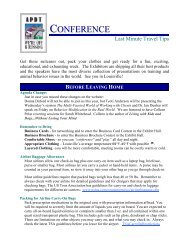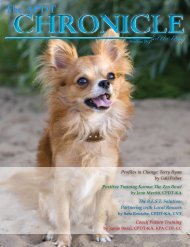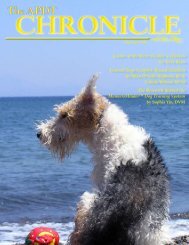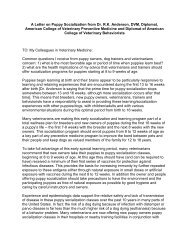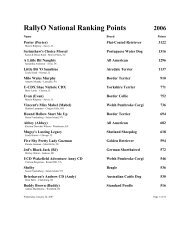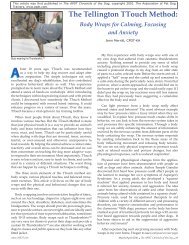of the Dog - Association of Pet Dog Trainers
of the Dog - Association of Pet Dog Trainers
of the Dog - Association of Pet Dog Trainers
You also want an ePaper? Increase the reach of your titles
YUMPU automatically turns print PDFs into web optimized ePapers that Google loves.
<strong>the</strong>y adopt <strong>the</strong> attitudes that yield <strong>the</strong> most productive<br />
relationships possible with all owners. (The external steps,<br />
or skills and interactions, are covered in part 2 <strong>of</strong> this<br />
article in <strong>the</strong> next issue.) The five suggestions that follow<br />
help create a mindset that engages <strong>the</strong> human clients in<br />
<strong>the</strong> process fully and overcomes many forms <strong>of</strong> owner<br />
resistance that can occur.<br />
First, remember that people are <strong>the</strong> way <strong>the</strong>y are for a reason.<br />
This is one <strong>of</strong> <strong>the</strong> simplest, yet most pr<strong>of</strong>ound things I<br />
learned from my mentor in graduate school. <strong>Trainers</strong><br />
know little <strong>of</strong> each owner’s upbringing, prior animal<br />
experiences, life struggles, emotional “baggage,” strengths,<br />
and resilience. It’s not <strong>the</strong> trainer’s job, <strong>of</strong> course, to delve<br />
into such things, but acknowledging this fact can increase<br />
trainers’ patience and understanding. For example, “know<br />
it all” clients are <strong>of</strong>ten quite insecure. They may have<br />
been raised by critical parents, and <strong>the</strong> “superiority” is<br />
actually a defense against fur<strong>the</strong>r criticism. This is not an<br />
excuse, and knowing it doesn’t reduce <strong>the</strong> unpleasantness<br />
<strong>of</strong> <strong>the</strong>ir arrogance, but when we remind ourselves that<br />
owners have been shaped by genetic and environmental<br />
factors, just as <strong>the</strong>ir dogs have been, it can s<strong>of</strong>ten our own<br />
tendency to judge. It may seem crazy to trainers, with<br />
all <strong>the</strong>ir expertise and experience with dogs, to hear that<br />
an owner thought <strong>the</strong> dog would “just behave” without<br />
training, but to <strong>the</strong> owner who has not had dog experience<br />
and has never learned any different, it’s not so crazy at all.<br />
They never even thought about it.<br />
Recently I took my <strong>the</strong>rapy dog to a dog-friendly store.<br />
As I entered, a couple came out with <strong>the</strong>ir undisciplined<br />
dog on a tight leash. Their dog lunged and was leash<br />
reactive when it saw my dog. I stepped to <strong>the</strong> side and<br />
cued my dog to sit. The couple stood blocking <strong>the</strong> doorway<br />
while <strong>the</strong>ir dog carried on, and I had nowhere to go. My<br />
immediate internal reaction was, “How stupid can <strong>the</strong>se<br />
people be? Just move—get out <strong>of</strong> our way!” On second<br />
thought, though, <strong>the</strong>y were not standing <strong>the</strong>re simply to<br />
cause my dog and me distress. They clearly didn’t know<br />
what to do and probably thought <strong>the</strong>y were doing <strong>the</strong><br />
right thing—holding <strong>the</strong>ir dog tightly so it wouldn’t attack.<br />
Once I gained this perspective, I simply asked <strong>the</strong>m to<br />
keep walking away and to loosen <strong>the</strong>ir leash once <strong>the</strong>y got<br />
past us.<br />
Second, realize that resistance is normal when people learn<br />
something new or try to change. When people learn or<br />
attempt change, <strong>the</strong>y naturally question and struggle with<br />
new concepts. In essence <strong>the</strong>y are “trying on” <strong>the</strong> new<br />
ideas, and <strong>the</strong>y don’t quite fit immediately. Psychological<br />
research and common sense suggest that it is important<br />
for people to feel in control <strong>of</strong> <strong>the</strong>ir lives. When control<br />
is not possible, predictability helps people cope and<br />
adapt to situations. Owners can feel vulnerable as <strong>the</strong>y<br />
wrestle with <strong>the</strong>ir rambunctious dog and try complex new<br />
behaviors to manage it. They feel out <strong>of</strong> control, and <strong>the</strong>y<br />
don’t know what will come next. That is a situation ripe<br />
for defensiveness, and defensiveness must be reduced in<br />
order for people to remain open to learning. Most <strong>of</strong> <strong>the</strong><br />
difficulties that trainers face with <strong>the</strong>ir human clients<br />
stem from owners’ lack <strong>of</strong> knowledge, lack <strong>of</strong> experience,<br />
www.APDT.com<br />
and anxiety. Resistance should be viewed as a sign <strong>of</strong><br />
active learning and/or a reflection <strong>of</strong> anxiety. Both deserve<br />
patience and understanding by <strong>the</strong> trainer.<br />
An owner <strong>of</strong> a Doberman met with his dog trainer for <strong>the</strong><br />
first time. His one-year-old dog wore a prong collar. When<br />
<strong>the</strong> trainer explained that she didn’t use prong collars and<br />
preferred o<strong>the</strong>r equipment, <strong>the</strong> owner argued, “But <strong>the</strong>se<br />
collars don’t hurt! I even put on <strong>the</strong> rubber tips! They just<br />
help control <strong>the</strong> dog. A dog like this needs to be under<br />
control!” On <strong>the</strong> surface, <strong>the</strong> owner’s objections sound like<br />
pure stubbornness. Why did he come for training if he<br />
didn’t want advice? What is more likely, however, is that <strong>the</strong><br />
owner felt vulnerable and at a loss as to how to control his<br />
dog. His security was wrapped up in <strong>the</strong> prong collar, and<br />
he had not yet learned any alternatives. When <strong>the</strong> trainer<br />
suggested o<strong>the</strong>r equipment, he may have felt vulnerable<br />
because he didn’t know how to control <strong>the</strong> dog o<strong>the</strong>rwise<br />
(loss <strong>of</strong> control), he did not yet know that <strong>the</strong> trainer’s<br />
options would probably work (loss <strong>of</strong> predictability), and<br />
because he had made a “mistake” in <strong>the</strong> trainer’s eyes and<br />
felt embarrassed. He wasn’t stubborn—he was anxious,<br />
and it would be difficult for him to absorb new information<br />
until his anxiety was alleviated. Being aware <strong>of</strong> humans’<br />
need for control, especially when learning new things, can<br />
increase trainers’ sensitivity and likelihood <strong>of</strong> doing <strong>the</strong><br />
most helpful things.<br />
Third, try to defer negative first impressions until you know<br />
<strong>the</strong> person better. Studies suggest that most <strong>of</strong> us form<br />
impressions <strong>of</strong> new people in less than a minute. When dog<br />
owners attend training sessions, <strong>the</strong>ir anxiety can bring<br />
out <strong>the</strong>ir less flattering characteristics. Anxiety usually<br />
dissipates as <strong>the</strong>y get to know <strong>the</strong> trainer and become more<br />
involved in <strong>the</strong> activities, and a different impression is<br />
likely to emerge.<br />
Fourth, avoid thinking <strong>of</strong> resistance as an all-or-nothing<br />
phenomenon. Even frustrating owners have <strong>the</strong>ir strengths.<br />
Ra<strong>the</strong>r than mentally labeling someone as “resistant,” or a<br />
“jerk,” or as “lazy,” it is better for trainers to reframe <strong>the</strong>ir<br />
thoughts in <strong>the</strong> following way. Think about and look for<br />
things each person is doing well at <strong>the</strong> same time making<br />
note <strong>of</strong> things <strong>the</strong>y struggle with. This reduces <strong>the</strong> all-ornothing<br />
thinking that can lock in a negative attitude.<br />
For example, one trainer found himself becoming<br />
increasingly irritated with an owner who talked incessantly<br />
to her dog in an annoying squeaky voice. She seemed unable<br />
to stop even when asked. He caught himself thinking<br />
she was a bit “ditzy” and <strong>the</strong>n forced himself to look for<br />
areas where she did do as asked. He noticed that her hand<br />
gestures were done well, and he felt more hopeful about her<br />
possibilities. He <strong>the</strong>n praised her consistent use <strong>of</strong> gestures<br />
and successfully redirected her energies to her nonverbal<br />
communication.<br />
Fifth, think <strong>of</strong> <strong>the</strong> training role as that <strong>of</strong> a teacher and partner<br />
ra<strong>the</strong>r than expert. <strong>Trainers</strong> have tremendous expertise<br />
to share, but when <strong>the</strong>y think <strong>of</strong> <strong>the</strong>mselves as experts<br />
in relation to <strong>the</strong>ir human clients, hidden expectations<br />
can detract from <strong>the</strong> relationship. Owners can expect<br />
<strong>the</strong> “expert” trainer to have all <strong>the</strong> [continued on next page]<br />
November/December 2008 w The APDT Chronicle <strong>of</strong> <strong>the</strong> <strong>Dog</strong> w 15<br />
Engaging Owners Fully in <strong>Dog</strong> Training



